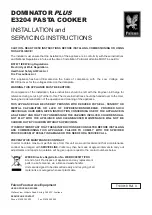
8
01-2018 5035 01
HYGIENE AND CLEANING
This manual shows the potential weak
points and includes information about
controlling the possible growth of bac-
teria.
Under the current health and safety
regulations, the operator of the appli-
ance must apply the self-control pro-
cedures, identified in accordance with
the HACCP (Hazard Analysis Critical
Control Point) Directive and national
legislation.
It is also a good idea to sanitise the surfaces
which do not come into direct contact with
the food inside the appliance, as well as the
side modules (cup warmers, coolers, etc.).
The sanitisation must be performed using
disinfectants, taking care to mechanically
remove the residues and visible films using
swabs and/or brushes.
Do not use solvents and/or strong-scented
detergents.
Some parts of the appliance can be dam-
aged by aggressive detergents.
The manufacturer shall not be held respon-
sible for any damage caused due to the
non-observance of the above or the use of
aggressive or toxic chemical products.
Do not under any circumstances use
water jets to clean the appliance.
9
1
2
3
5
6
7
8
10
11
13
4
12
14
Fig. 4
1. Hot water spout*
2. Nozzle-moving handle
3. Brewing unit
4. Diffuser nozzle*
5. Decaffeinated coffee chute*
6. Door lock
7. Door for decaf
8. Container lock*
9. Container cover
10. Product container
11. Mixer*
12. Milk frother nozzle
13. Milk hose**
14. Steam nozzle**
* Only some models.
** Only models with a cappuccino maker.
















































